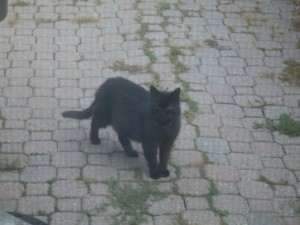Written by Jenny Aggio, November 2012
 You see them everywhere: living in ravines, scattered in alleyways. Feral cats are all around us, and they have become but a mere addition to our ordinary lives, not many people even give these poor souls a second glance.
You see them everywhere: living in ravines, scattered in alleyways. Feral cats are all around us, and they have become but a mere addition to our ordinary lives, not many people even give these poor souls a second glance.
They are too wild to live indoors, they have been born and raised outside and were taught to fear humans. They hunt and scavenge through garbage to find nourishment for their next meals.
But one initiative that many cat rescue advocates have is to improve the lives of feral cats. They strive to feed and care for these cats, provide them with love and comfort and if possible, give them forever homes (if not, have them fixed, vaccinated, and returned to their colony). There are so many ways in which you can open your heart to these homeless animals, so many ways that you can help! Every loving action towards this poor souls makes a huge impact.
Get Educated.
The first thing that you can do to help feral cats in your neighborhood is to get educated. Find out about local cat rescue organizations, no-kill shelters, feral cat programs and by-laws on animals in your area. Once you are armed with this information, you should make a list of all organizations in your area that could possibly help you work with these cats.
Secondly, if you are feeding a group of homeless cats in a public place, you should remember that being as transparent as possible would be best in this situation. You really don’t want people to know what you are doing because this could cause situations with angry neighbors and landlords, and possibly alert people who would want to harm the cats.
Make sure the cats are protected from weather conditions.
Make sure that food dishes and water dishes are concealed in a feeding station (even if it is a sideways box with an opening that would allow the cats to come in and eat), which will also protect the food from weather and the elements.
Shelter is very, very important to feral cats. Remember, depending on where you live, these cats must live outside in the rain, snow and wind. You must create a comfortable, dry place that will provide some sort of shelter to these cats during spells of bad weather.
Now, some people get really creative with this! You can build a wooden house, or anything you want really, but what I do and believe is most cost effective is what I call the “Rubbermaid House”. Begin by cutting a hole 5 1/2″ in diameter in the Rubbermaid (plastic) bin, and purchase tubing that is also 5 1/2″ in diameter. Cut a length of tubing large enough to form a tunnel for the kitties to go through and attach this to the hole you cut in the bin, so the shelter will be protected from snow and rain. Then you can add styrofoam for insulation, hay, and insulated blankets, and place the lid on the top. Super simple and cost effective! As long as your feral cats have a nice, dry place to retreat to during bad weather, they will be ok.
If you are feeding in a public place, please try to conceal or camouflage the shelter, just so people passing by won’t realize kitties are in there!
What should I feed a feral cat?
 This is a common question among colony caretakers. Even though raw is the most natural and best diet available, it is not always affordable to those taking care of feral cats. My advice to you is that, if you cannot afford to feed your feral cats a high quality food (especially if you are feeding a large number of cats), don’t fret! It is perfectly acceptable to feed what you can afford – remember that all your hard work is so appreciated by these cats and you are providing them with a high quality of life.
This is a common question among colony caretakers. Even though raw is the most natural and best diet available, it is not always affordable to those taking care of feral cats. My advice to you is that, if you cannot afford to feed your feral cats a high quality food (especially if you are feeding a large number of cats), don’t fret! It is perfectly acceptable to feed what you can afford – remember that all your hard work is so appreciated by these cats and you are providing them with a high quality of life.
What you are feeding these cats simply supplements their diet. They do not only eat what you are feeding them – they hunt. When they are hunting, they are eating raw, natural, carnivorous food. So really, they are getting the nutrients they need and they are eating raw!
Many colony caretakers place donation boxes in local pet stores. This is a great idea, if you can get the owner of the store to agree with this, fantastic. This way you are not breaking the bank and you are still able to feed your cats a variety of foods!
TNR…Trap, Neuter, Return!
Honestly, the first time I heard about TNR I thought…hey what? But it is seriously the best, most humane solution to overpopulation concerns and it benefits the health and quality of life of the cats, as well.
So what is Trap Neuter Return? It is a way of making sure cats in your colony are not constantly reproducing, and also a way of keeping your colony healthy and disease free.
There are many feral cat advocacy programs all over the United States and Canada, as well as in many other countries. Most of these programs are free, or low cost.
 The hardest part of Trap Neuter Return (well…in my opinion!) is the trapping. Before all of this, have your spay/neuter appointments scheduled ahead of time. You must first get ahold of a humane drop trap, and these can be borrowed from your veterinarian, local humane society, or even purchased at many hardware stores. Tomahawk and Havahart are two of the most common brands.
The hardest part of Trap Neuter Return (well…in my opinion!) is the trapping. Before all of this, have your spay/neuter appointments scheduled ahead of time. You must first get ahold of a humane drop trap, and these can be borrowed from your veterinarian, local humane society, or even purchased at many hardware stores. Tomahawk and Havahart are two of the most common brands.
Set the trap, and place a tiny bit of a special treat on a piece of cardboard at the back of the trap. Try to think of a food that is as stinky and yummy to kitties as possible – fish, usually tuna, works best (although should not be fed as a permanent diet, only in small amounts for trapping purposes). Then just hide, and wait! Once you get a cat trapped, place a sheet over the trap and bring the cat into a safe place where it can calm down.
The rest is simple. Just bring the cat(s) in for the appointment! After they are fixed, please recover the cats in a warm, dry space – females must be recovered 3-4 days and males only overnight. Then just release the cats to their original location. There you go, you’ve TNR’d!
Keep records, files and spreadsheets organized.
The best way to manage your colony is to stay organized. Have a spreadsheet handy of who got neutered, vaccinated, dewormed, veterinary care and when and where. This is extremely important so you can keep track of the cats. Every cat that you see, name him/her and put them on the spreadsheet. Also, retain records of spay/neuters, vaccinations, etc. of each cat and give each cat their separate folder. This way, everything will be handy right when you need it!
If your city has a feral cat outreach program – register your colony! This will ensure that if any of your ear tipped cats go missing, they may be able to be recovered if they are recognized in your neighborhood.
Offer love, care, a nd support!
nd support!
Just be there for these cats. Talk to them as you feed them, let them know when you are going to be trapping. Routine is a great thing, too, so have a schedule on which you feed them.
And most of all, pat yourself on the back – you are fantastic for helping these cats and devoting your money, effort and time!
If you enjoyed this article or found it informative, please “Like” it, “Tweet” it, or share it using any of the buttons below. And don’t forget to check out our FB page, join the discussions in our awesome FB group and follow us on Twitter!
Created 11/19/12; Updated 08/11/14

